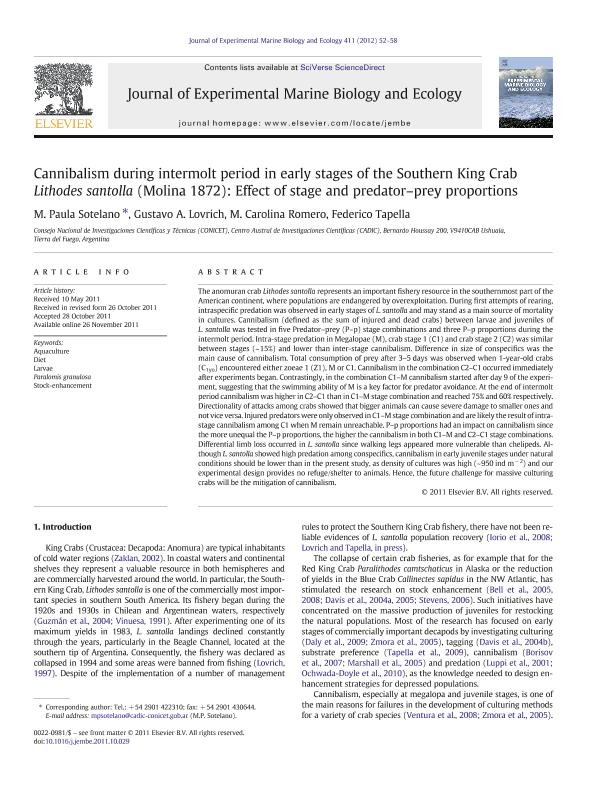Mostrar el registro sencillo del ítem
dc.contributor.author
Sotelano, María Paula

dc.contributor.author
Lovrich, Gustavo Alejandro

dc.contributor.author
Romero, Maria Carolina

dc.contributor.author
Tapella, Federico

dc.date.available
2021-09-21T15:07:08Z
dc.date.issued
2012-01
dc.identifier.citation
Sotelano, María Paula; Lovrich, Gustavo Alejandro; Romero, Maria Carolina; Tapella, Federico; Cannibalism during intermoult period in early stages of the Southern King Crab Lithodes santolla (Molina 1872): Effect of stage and predator-prey proportions; Elsevier Science; Journal of Experimental Marine Biology and Ecology; 411; 1-2012; 52-58
dc.identifier.issn
0022-0981
dc.identifier.uri
http://hdl.handle.net/11336/141014
dc.description.abstract
The anomuran crab Lithodes santolla represents an important fishery resource in the southernmost part of the American continent, where populations are endangered by overexploitation. During first attempts of rearing, intraspecific predation was observed in early stages of L. santolla and may stand as a main source of mortality in cultures. Cannibalism (defined as the sum of injured and dead crabs) between larvae and juveniles of L. santolla was tested in five Predator-prey (P-p) stage combinations and three P-p proportions during the intermolt period. Intra-stage predation in Megalopae (M), crab stage 1 (C1) and crab stage 2 (C2) was similar between stages (~15%) and lower than inter-stage cannibalism. Difference in size of conspecifics was the main cause of cannibalism. Total consumption of prey after 3-5days was observed when 1-year-old crabs (C 1yo) encountered either zoeae 1 (Z1), M or C1. Cannibalism in the combination C2-C1 occurred immediately after experiments began. Contrastingly, in the combination C1-M cannibalism started after day 9 of the experiment, suggesting that the swimming ability of M is a key factor for predator avoidance. At the end of intermolt period cannibalism was higher in C2-C1 than in C1-M stage combination and reached 75% and 60% respectively. Directionality of attacks among crabs showed that bigger animals can cause severe damage to smaller ones and not vice versa. Injured predators were only observed in C1-M stage combination and are likely the result of intra-stage cannibalism among C1 when M remain unreachable. P-p proportions had an impact on cannibalism since the more unequal the P-p proportions, the higher the cannibalism in both C1-M and C2-C1 stage combinations. Differential limb loss occurred in L. santolla since walking legs appeared more vulnerable than chelipeds. Although L. santolla showed high predation among conspecifics, cannibalism in early juvenile stages under natural conditions should be lower than in the present study, as density of cultures was high (~950indm -2) and our experimental design provides no refuge/shelter to animals. Hence, the future challenge for massive culturing crabs will be the mitigation of cannibalism.
dc.format
application/pdf
dc.language.iso
eng
dc.publisher
Elsevier Science

dc.rights
info:eu-repo/semantics/openAccess
dc.rights.uri
https://creativecommons.org/licenses/by-nc-sa/2.5/ar/
dc.subject
AQUACULTURE
dc.subject
DIET
dc.subject
LARVAE
dc.subject
PARALOMIS GRANULOSA
dc.subject
STOCK-ENHANCEMENT
dc.subject.classification
Biología Marina, Limnología

dc.subject.classification
Ciencias Biológicas

dc.subject.classification
CIENCIAS NATURALES Y EXACTAS

dc.title
Cannibalism during intermoult period in early stages of the Southern King Crab Lithodes santolla (Molina 1872): Effect of stage and predator-prey proportions
dc.type
info:eu-repo/semantics/article
dc.type
info:ar-repo/semantics/artículo
dc.type
info:eu-repo/semantics/publishedVersion
dc.date.updated
2021-08-13T16:19:52Z
dc.journal.volume
411
dc.journal.pagination
52-58
dc.journal.pais
Países Bajos

dc.journal.ciudad
Amsterdam
dc.description.fil
Fil: Sotelano, María Paula. Consejo Nacional de Investigaciones Científicas y Técnicas. Centro Austral de Investigaciones Científicas; Argentina
dc.description.fil
Fil: Lovrich, Gustavo Alejandro. Consejo Nacional de Investigaciones Científicas y Técnicas. Centro Austral de Investigaciones Científicas; Argentina
dc.description.fil
Fil: Romero, Maria Carolina. Consejo Nacional de Investigaciones Científicas y Técnicas. Centro Austral de Investigaciones Científicas; Argentina
dc.description.fil
Fil: Tapella, Federico. Consejo Nacional de Investigaciones Científicas y Técnicas. Centro Austral de Investigaciones Científicas; Argentina
dc.journal.title
Journal of Experimental Marine Biology and Ecology

dc.relation.alternativeid
info:eu-repo/semantics/altIdentifier/url/http://www.sciencedirect.com/science/article/pii
dc.relation.alternativeid
info:eu-repo/semantics/altIdentifier/doi/https://doi.org/10.1016/j.jembe.2011.10.029
Archivos asociados
